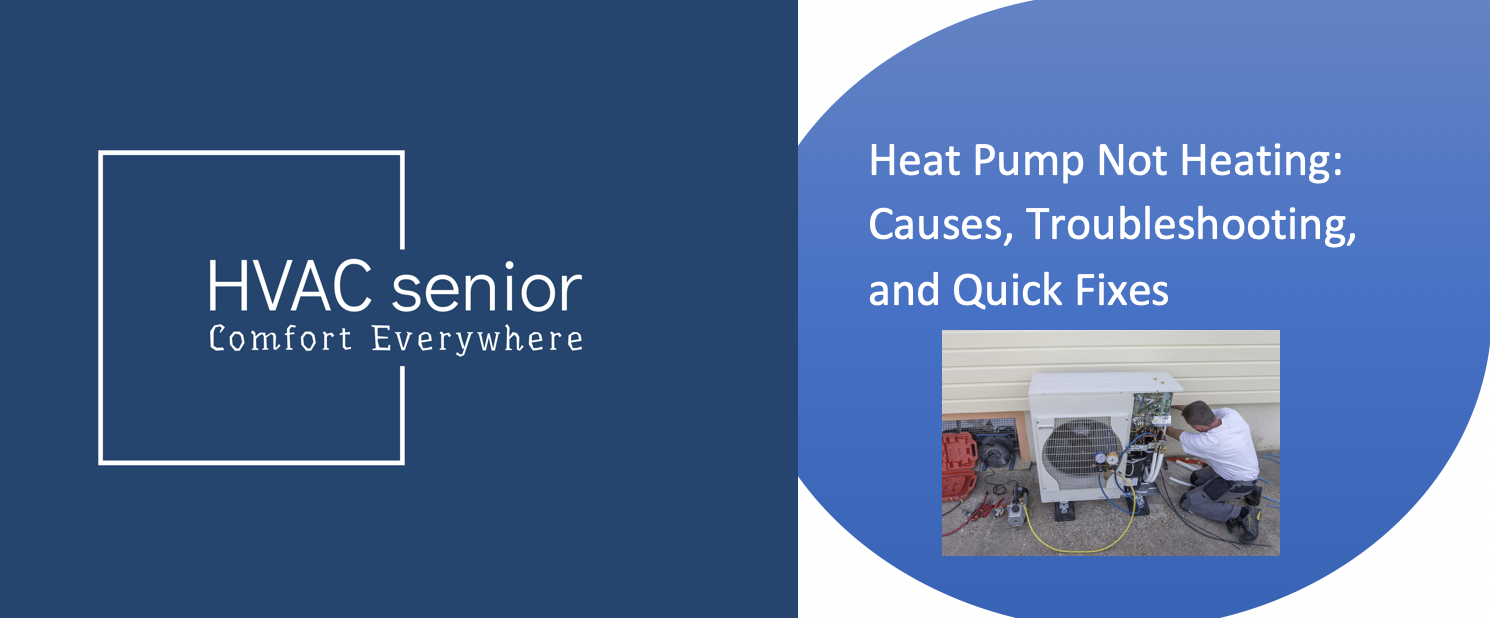A cold day can become a frustrating one when your heat pump is not heating. Whether it’s blowing cold air, taking longer than expected to reach your set temperature, or simply running without heat—don’t panic.
Heat pumps are efficient and reliable; however, like any HVAC system, their performance could be thrown off due to weather conditions, an electrical problem, refrigerant leak, or system malfunction.
In this post, we’ll explain why your heat pump isn’t heating, how to troubleshoot the problem, and when it’s time to call an HVAC professional.
How a Heat Pump Heats Your Home
To understand what’s wrong, it helps to know how a heat pump works.
Unlike a furnace, which makes heat, a heat pump does not; it moves heat from outside air into your home using refrigerant.
Here’s the basic process:
1. The outdoor unit absorbs heat from the outside air.
2. The refrigerant, now compressed, becomes hot.
3. That heat is discharged indoors by the indoor coil.
If your heat pump isn’t heating properly, something is interrupting this cycle — either by restricting airflow, blocking heat transfer, or failing to reverse the refrigerant flow.
Also read: Mini Split Heat Pump
Signs That Your Heat Pump Is Not Heating Properly
Before attempting to identify causes and fixes, confirm the symptoms:
• Air coming from vents is cool or lukewarm
• System operates continuously without heating your house
• The outdoor unit is covered with ice or frost
• Unusual noises: clicking, hissing, or grinding
• Thermostat is set to heat, but temperature doesn’t rise
If one or more of these apply, let’s explore what could be wrong.
10 Common Reasons Your Heat Pump Isn’t Heating
1. Incorrect Thermostat Settings
It may sound simple, but the wrong settings on your thermostat are the most common reasons why your heat pump is not heating.
If your thermostat is set to “cool” instead of “heat” or “auto,” your system will blow cold air.
Solution:
• Your thermostat should be set to HEAT mode.
• Increase the temperature setting by 2–4 degrees above the current room temperature.
• Check the fan setting — “AUTO” is better than “ON,” which can blow unheated air between cycles.
Replace the batteries or check wiring if the display of the thermostat is either blank or unresponsive.
2. Frozen or Clogged Outdoor Unit
In cold or humid weather, a heat pump’s outdoor coil can freeze. This prevents your system from absorbing heat from the outside air and causes it to blow cold or lukewarm air.
Correctness:
• Check the outdoor unit for ice buildup or debris.
• Shut the system off and let it defrost on its own.
• Clear snow, leaves, and dirt from around the unit to ensure proper airflow.
• If freezing keeps happening, the defrost cycle or sensor might be faulty — call a technician.
3. Dirty Air Filter Restricting Airflow
A clogged air filter can choke airflow, preventing the heat pump from transferring heat efficiently. This results in poor heating and higher energy bills.
Corrections:
• Replace the air filter every 30-60 days, depending on usage.
• Choose a filter with the appropriate MERV rating for your unit (higher ratings restrict airflow).
A clean filter ensures a steady, warm airflow and does not stress your system.
4. Low Refrigerant Levels
The refrigerant itself plays a critical role in heat transfer. If the refrigerant is low in your heat pump, then it simply cannot absorb enough heat from the outside air, thus making it output cool or no heat at all.
Signs of a refrigerant problem:
Hissing or bubbling sounds
• Ice on refrigerant lines or the outdoor coil
• Weak airflow and poor heating performance
Fix:
Refrigerant leaks must be handled by a licensed HVAC technician. They will find and seal the leak and then recharge the system to proper levels.
5. Faulty Reversing Valve
It’s the reversing valve that enables your heat pump to change between heating and cooling modes. If it fails, then your system might get stuck in cooling mode, blowing cold air when set to heat.
Fix:
• Confirm the thermostat is correctly signaling “heat mode.”
• If the problem persists, the reversing valve may need to be replaced by an HVAC professional.
Also read: Ductless Heat Pump
6. Dirty Coils (Indoor or Outdoor)
Both the evaporator coil indoors and the condenser coil outdoors are essential in the process of heat transfer. When these coils become dirty, efficient heat transfer cannot take place, and the system performs poorly.
Fix:
• Turn off power to the unit.
• Clean coils gently using a coil cleaner or low-pressure water rinse.
• For substantial amounts of dirt, allow professional cleaning service for coils.
7. Defective Defrost Control Board
Your defrost control board monitors frost on the outdoor coil and engages the defrost cycle automatically. Failure of this board may cause the coil to remain frozen, potentially reducing the heating capability.
Fix:
Call the HVAC technician to test and, if needed, replace the defrost control board or sensor.
8. Electrical Problems or Tripped Breaker
Sometimes, the heat pump isn’t heating simply because the outdoor unit lost power due to a tripped breaker, blown fuse, or electrical fault.
Fix:
• Check your breaker box for tripped switches and reset if needed.
• Inspect outdoor disconnect boxes.
• If the breakers continually trip, call a professional: it may be a short circuit or failing component.
9. Leaky or Poorly Insulated Ductwork
If your ductwork is leaking, the heated air has escaped before it reaches your vents, making your home feel colder even when the heat pump seems to be running fine.
Fix:
• Inspect ducts for loose connections or gaps.
• Seal with mastic sealant or aluminum foil tape.
• Consider professional duct testing and insulation to reduce heat loss.
10. Auxiliary Heat Not Engaging
In very cold weather, your heat pump relies on auxiliary – or backup – electric heat to maintain indoor comfort. If this system fails, your home may feel cold even though the heat pump runs.
Solution:
• Check your thermostat display for terms like “AUX HEAT” or “EM HEAT”.
• If it doesn’t turn on, the relay or heating strip may need servicing.
How to Troubleshoot a Heat Pump Not Heating
Here’s a quick, step-by-step troubleshooting checklist you can follow before calling a technician:
1. Thermostat check: Make sure it’s on HEAT and set higher than the room temperature.
2. Air filter inspection: Replace if dirty/clogged.
3.Look for outdoor ice buildup. If necessary, defrost manually.
4. Clear debris: Snow, dirt, or leaves might be blocking the path of airflow and must be removed.
5. Circuit breaker check: reset the tripped ones.
6. Test airflow: Vents should be open and unblocked.
7.Observe defrost cycle: If the outdoor unit does not defrost automatically, then there is a control problem.
If the heat pump is still not heating after these steps, then professional diagnosis is necessary.
Also read: Heat Pump Not Working
Professional Repairs and Maintenance
Issues such as low refrigerant, failure in the reversing valve, and defects in the defrost control can be identified by an experienced HVAC technician with ease.
Routine maintenance generally encompasses:
• Refrigerant level checks
• Cleaning coils and filters
Electrical connections checks
• Lubricating motors and fans
• Testing thermostat calibration
You should schedule professional maintenance twice a year: once before winter for heating and once before summer for cooling.
Preventive Maintenance Tips to Avoid Heating Problems
Keeping your heat pump running efficiently throughout winter doesn’t need much in the way of effort-just consistent care.
- Replace the filters regularly.
- Keep outdoor units clear of obstruction
- Schedule biannual maintenance
- Ducts should be inspected annually
- Check performance of thermostat
- Check for unusual noises or longer run times
Preventive care reduces wear, improves heating performance, and prolongs your heat pump’s life.
When to Replace Your Heat Pump
If your system is older than 12 to 15 years, or if repairs are becoming frequent and costly, it’s probably better to replace than to repair.
New heat pumps offer:
• Higher energy efficiency: up to 20 SEER
• Quieter operation
• Smart thermostat compatibility
• Lower heating costs
A professional consultation in HVAC will help in weighing up whether repair or replacement is the better long-term investment.
Final Thoughts
Most heating problems with heat pumps can be related to factors like dirty filters, thermostat errors, or airflow restrictions, but it may also indicate more serious issues such as refrigerant leaks, failure of the reversing valve, or electrical problems.
Begin with easy DIY checks; if the problem persists, call in a certified HVAC technician who can perform a full-system diagnosis.
Regular maintenance and a little TLC will keep the heat pump chugging for years.















